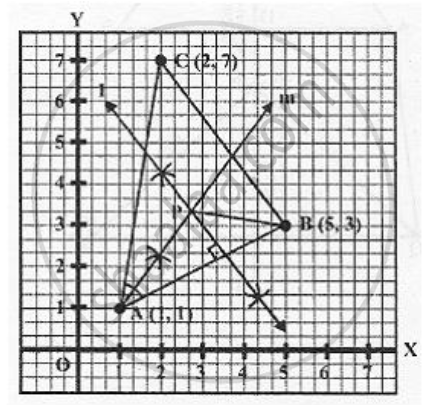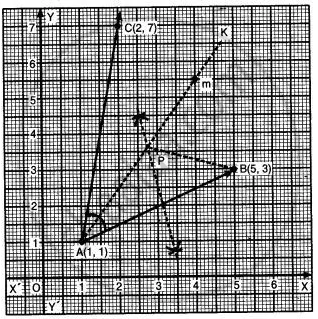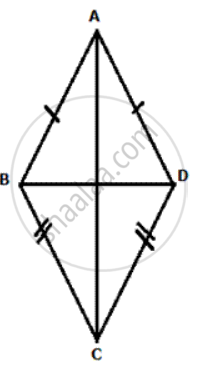Advertisements
Advertisements
प्रश्न
Use graph paper for this question. Take 2 cm = 1 unit on both the axes.
- Plot the points A(1, 1), B(5, 3) and C(2, 7).
- Construct the locus of points equidistant from A and B.
- Construct the locus of points equidistant from AB and AC.
- Locate the point P such that PA = PB and P is equidistant from AB and AC.
- Measure and record the length PA in cm.
उत्तर १

Steps of Construction:
- Plot the points A(1, 1), B(5, 3) and C(2, 7) on the graph and join AB, BC and CA
- Now we should join points A and B. Draw perpendicular bisector l of AB. Then, l is the locus of points which are equidistant from A and B.
- Now we should join A and C. Also draw the angle bisector m of ∠CAB. Then, m is the locus of points equidistant from AB and AC.
- Draw the perpendicular bisector of AB and angle bisector of angle A which intersect each other at P. P is the required point. Since P lies on the perpendicular bisector of AB. Therefore, P is equidistant from A and B.
Again,
Since P lies on the angle bisector of angle A.
Therefore, P is equidistant from AB and AC. - On measuring, the length of PA = 2.5 cm
उत्तर २

- Plot the points A(1, 1), B(5, 3) and C(2, 7) as shown.
- Join points A and B. Draw right bisector l of AB. Then, l is the locus of points equidistant from A and B.
- Join A and C. Now draw the bisector m of ∠CAB. Then, m is the locus of points equidistant from AB and AC.
- The point of intersection P of right bisector of AB and angle bisector of ∠CAB is the point such that PA = PB and P is equidistant from AB and AC.
- On measuring PA = 2.5 cm.
संबंधित प्रश्न
Construct an isosceles triangle ABC such that AB = 6 cm, BC = AC = 4 cm. Bisect ∠C internally and mark a point P on this bisector such that CP = 5 cm. Find the points Q and R which are 5 cm from P and also 5 cm from the line AB.
AB and CD are two intersecting lines. Find a point equidistant from AB and CD, and also at a distance of 1.8 cm from another given line EF.
Without using set squares or protractor, construct a quadrilateral ABCD in which ∠ BAD = 45° , AD = AB = 6 cm, BC= 3.6 cm and CD=5 cm. Locate the point P on BD which is equidistant from BC and CD.
In given figure, ABCD is a kite. AB = AD and BC =CD. Prove that the diagona AC is the perpendirular bisector of the diagonal BD.

Describe completely the locus of point in the following cases:
Midpoint of radii of a circle.
Without using set squares or protractor construct a triangle ABC in which AB = 4 cm, BC = 5 cm and ∠ABC = 120°.
(i) Locate the point P such that ∠BAp = 90° and BP = CP.
(ii) Measure the length of BP.
Using ruler and compasses construct:
(i) a triangle ABC in which AB = 5.5 cm, BC = 3.4 cm and CA = 4.9 cm.
(ii) the locus of point equidistant from A and C.
(iii) a circle touching AB at A and passing through C.
Using only a ruler and compass construct ∠ABC = 120°, where AB = BC = 5 cm.
(i) Mark two points D and E which satisfy the condition that they are equidistant from both ABA and BC.
(ii) In the above figure, join AD, DC, AE and EC. Describe the figures:
(a) AECB, (b) ABD, (c) ABE.
Without using set squares or protractor construct:
(i) Triangle ABC, in which AB = 5.5 cm, BC = 3.2 cm and CA = 4.8 cm.
(ii) Draw the locus of a point which moves so that it is always 2.5 cm from B.
(iii) Draw the locus of a point which moves so that it is equidistant from the sides BC and CA.
(iv) Mark the point of intersection of the loci with the letter P and measure PC.
Given ∠BAC (Fig), determine the locus of a point which lies in the interior of ∠BAC and equidistant from two lines AB and AC.
